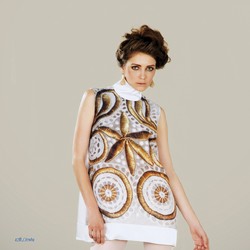Oľga Danglová
The author of the article examines the forms and objectives of clothing folklorism in Slovakia from the mid 20th century until now. The socialism era and collectivisation eliminated folk clothes from the countryside in Slovakia. On the other hand, the contemporary regime supported folk traditions, incorporated them into the then-ideology and culture and misused it as a suitable means of propaganda aimed at the “power of working people”. They used folklorism to demonstrate the support for people, they supported folk groups and ensembles in villages, folklore festivals in which folk clothes worked as stage costumes. Strength of such cultural policy was that members of folklore groups searched their villages to find original clothes and they learnt from experience of old women. The Centre for Folk Art Production (ÚĽUV) and the Institute of Ethnology of the Slovak Academy of Sciences have initiated a rescue on-site research of folk clothes.
Folk clothes inspirations in fashion and fashion industry during the socialism era were not very popular. However, ordinary female wardrobe of the 1950s and 1960s included embroidered blouses and skirts and blueprint aprons.
The ÚĽUV also used folk costumes to harmonise them with contemporary clothing. The ÚĽUV visual artists have used older clothing styles in their designs since the 1960s. They have used colours of natural materials and simple shapes of folk clothes. They have rejected lively ornaments, manifold colours and industrial materials.
Folk clothes are rarely worn in rural environment now. Folk costumes are used commercially, when local people wear them for tourists, or during folklore festivals or folk craft events. Traditional clothes are sporadically used during wedding ceremonies to make it special and unusual. Web pages offer quite wide range of sewing and rental services regarding folk clothes.
Variety of folklorism forms in modern design includes adjustments of traditional clothes and decorations. The ÚĽUV supports similar design-supporting activities (ÚĽUV Design Studio, Rings in Water competition). Folk clothing is included in the post-modern style, design incorporates traditional forms, motives or contexts. Range of forms includes direct quotations, indications or crazy ideas with hardly any or no connection with tradition.
Now, folklorism in clothing is involved in the consumer society as fun or a commercial product.
